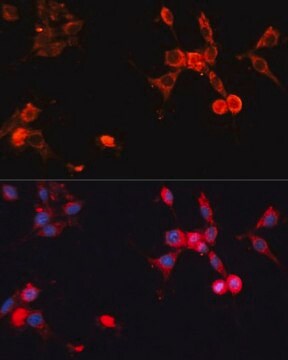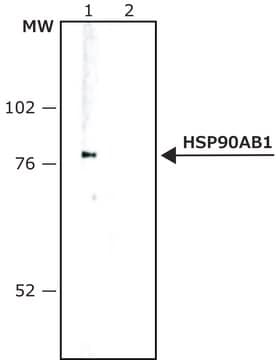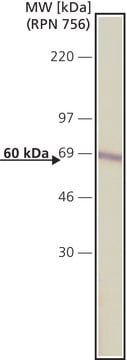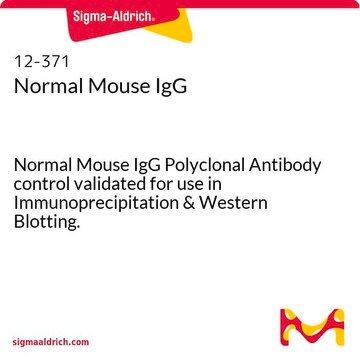F6522
IgG2a−FITC Isotype Control from murine myeloma
clone UPC-10, purified immunoglobulin, buffered aqueous solution
Synonyme(s) :
IgG2a−Fluorescein isothiocyanate
Se connecterpour consulter vos tarifs contractuels et ceux de votre entreprise/organisme
About This Item
Code UNSPSC :
12352203
Nomenclature NACRES :
NA.46
Produits recommandés
Source biologique
mouse
Niveau de qualité
Conjugué
FITC conjugate
Forme d'anticorps
purified immunoglobulin
Clone
UPC-10, monoclonal
Forme
buffered aqueous solution
Conditions de stockage
protect from light
Technique(s)
flow cytometry: suitable
Conditions d'expédition
wet ice
Température de stockage
2-8°C
Modification post-traductionnelle de la cible
unmodified
Catégories apparentées
Description générale
IgG2a (immunoglobulin G 2a) is one of the subclasses of rat immunoglobulins, which also include IgG1, IgG2b and IgG2c.
Spécificité
Mouse IgG2a, κ, antibodies react with anti-mouse whole serum, anti-mouse IgG2a and anti-mouse κ chain immunoglobulins. The antibody preparation, IgG2a, does not react with antisera to mouse IgA, IgM, IgG1, IgG2b, IgG3 and λ light chain immunoglobulins in Ouchterlony double diffusion assays. IgG2a-FITC conjugate can be used as controls in immunoassays.
Application
IgG2a FITC Isotype Control from murine myeloma has been used in dual-colour staining and in cell staining for flow cytometry.
Actions biochimiques/physiologiques
Immunoglobulin G (IgG) is a glycoprotein antibody that regulates immune responses such as phagocytosis and is also involved in the development of autoimmune diseases . Mouse IgGs have four distinct isotypes, namely, IgG1, IgG2a, IgG2b, and IgG3. IgG1 regulates complement fixation in mice.
Forme physique
Solution in 0.01 M phosphate buffered saline, pH 7.4, containing 1% bovine serum albumin and 15 mM sodium azide.
Notes préparatoires
Prepared by conjugation to fluorescein isothiocyanate isomer I (FITC). This green dye is efficiently excited at 495 nm and emits at 525 nm.
Clause de non-responsabilité
Unless otherwise stated in our catalog or other company documentation accompanying the product(s), our products are intended for research use only and are not to be used for any other purpose, which includes but is not limited to, unauthorized commercial uses, in vitro diagnostic uses, ex vivo or in vivo therapeutic uses or any type of consumption or application to humans or animals.
Code de la classe de stockage
10 - Combustible liquids
Classe de danger pour l'eau (WGK)
nwg
Point d'éclair (°F)
Not applicable
Point d'éclair (°C)
Not applicable
Équipement de protection individuelle
Eyeshields, Gloves, multi-purpose combination respirator cartridge (US)
Faites votre choix parmi les versions les plus récentes :
Déjà en possession de ce produit ?
Retrouvez la documentation relative aux produits que vous avez récemment achetés dans la Bibliothèque de documents.
Expression of the Multiple Sclerosis-Associated MHC Class II Allele HLA-DRB1 * 1501 Is Regulated by Vitamin D
Ramagopalan SV, et al.
PLoS Genetics, 5(2), e1000369-e1000369 (2009)
Three classes and four (sub) classes of rat immunoglobulins: IgM, IgA, IgE and IgG1, IgG2a, IgG2b, IgG2c
Bazin H, et al.
European Journal of Immunology, 4, 44-48 (1974)
T Nakamura et al.
Proceedings of the National Academy of Sciences of the United States of America, 95(9), 5389-5394 (1998-06-06)
Activation of hepatic stellate (Ito) cells is a final common pathway of liver fibrosis. The findings presented in this paper indicate that expression of Na+/Ca2+ exchanger (NCX) emerges in rat hepatic stellate cells after activation in vitro during primary culture
J Schultz et al.
Cancer research, 60(23), 6663-6669 (2000-12-16)
Single-chain Fv antibody fragments from the CD20-specific murine monoclonal antibody B9E9 were genetically engineered as streptavidin fusions [single-chain Fv-streptavidin (scFvSA) fusion protein] for use in pretargeted radioimmunotherapy. The scFvSA constructs were expressed as soluble, tetrameric species in the periplasm of
Toll-like receptor mRNA expression patterns in human dendritic cells and monocytes
Kokkinopoulos I, et al.
Molecular Immunology, 42(8), 957-968 (2005)
Notre équipe de scientifiques dispose d'une expérience dans tous les secteurs de la recherche, notamment en sciences de la vie, science des matériaux, synthèse chimique, chromatographie, analyse et dans de nombreux autres domaines..
Contacter notre Service technique








